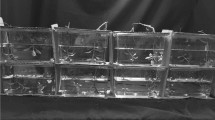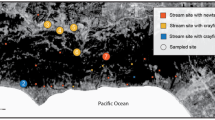Abstract
Species introduced outside their native range to serve anthropogenic purposes may have unintended consequences on native organisms. Mosquitofish (Gambusia affinis and Gambusia holbrooki) have been introduced throughout the world to control larval mosquito populations in aquatic environments, but they have also been implicated in the decline of native fish, amphibian, and aquatic invertebrate populations. We investigated the roles of introduced western mosquitofish (G. affinis), and two naturally colonizing predators (crayfish and dragonfly naiads) in inflicting tail injuries observed on ranid frog tadpoles in experimental constructed wetlands. We also examined the influence of vegetation in reducing tail injury severity. We found that mosquitofish significantly increased the prevalence and severity of tail injuries, but crayfish and dragonfly naiads contributed much less to increased injury levels. Furthermore, increased vegetation cover did not significantly attenuate tail injuries. However, after chemical removal of Gambusia, injury prevalence and severity was significantly reduced. Although previous investigations have concluded that mosquitofish prey upon the eggs and larvae of some amphibians, our results illustrate that these fish can cause substantial but apparently sub-lethal injuries to large numbers of larval amphibians in a wetland. Further investigations are needed to determine if these injuries impede the fitness of victims and lead to population reductions.





Similar content being viewed by others
References
Anderson, A. L. & W. D. Brown, 2009. Plasticity of hatching in green frogs (Rana clamitans) to both egg and tadpole predators. Herpetologica 65: 207–213.
Axelsson, E., P. Nyström, J. Sidenmark & C. Brönmar, 1997. Crayfish predation on amphibian eggs and larvae. Amphibia-Reptilia 18: 217–228.
Baber, M. J., 2001. Understanding Anuran Community Structure in Temporary Wetlands: The Interaction and Importance of Landscape and Biotic Processes. Ph.D. dissertation, Florida International University, Miami.
Baber, M. J. & K. J. Babbitt, 2003. The relative impacts of native and introduced predatory fish on a temporary wetland tadpole assemblage. Oecologia 136: 289–295.
Baber, M. J. & K. J. Babbitt, 2004. Influence of habitat complexity on predator-prey interactions between the fish (Gambusia holbrookii) and tadpoles of Hyla squirella and Gastrophryne carolinensis. Copeia 2004: 173–177.
Blair, J. & R. J. Wassersug, 2000. Variation in the pattern of predator-induced damage to tadpole tails. Copeia 2000: 390–401.
Bowerman, J., P. T. Johnson & T. Bowerman, 2010. Sublethal predators and their injured prey: linking aquatic predators and severe limb abnormalities in amphibians. Ecology 91: 242–251.
Byers, J. E., 2000. Competition between two estuarine snails: implications for invasions of exotic species. Ecology 81: 1225–1239.
Casterlin, M. E. & W. W. Reynolds, 1977. Aspects of habitat selection in the mosquitofish Gambusia affinis. Hydrobiologia 55: 125–127.
Chandler J. H. Jr & L. L. Marking, 1982. Toxicity of rotenone to selected aquatic invertebrates and frog larvae. Progressive Fish-Culturist 44: 78–80.
Duryea, R., J. Donnelly, D. Guthrie, C. O’Malley, M. Romanowski & R. Schmidt, 1996. Proceedings of the Eighty-Third Annual Meeting of the New Jersey Mosquito Control Association. Inc. 1996: 95–102.
Edgell, T. C., 2007. Evidence of Ecological and Evolutionary Interactions Between and Exotic Crab Carcinus maenas and Two Species of Littorina Snail in the Northwest Atlantic. Dissertation, The University of New Brunswick.
Finlay, J. C. & V. T. Vredenburg, 2007. Introduced trout sever trophic connections between lakes and watersheds: consequences for a declining amphibian. Ecology 88: 2187–2198.
Figiel C. R. Jr & R. D. Semlitsch, 1991. Effects of nonlethal injury and habitat complexity on predation in tadpole populations. Canadian Journal of Zoology 69: 830–834.
Fontenot, L. W., G. P. Noblet & S. G. Platt, 1994. Rotenone hazards to reptiles and amphibians. Herpetological Review 25(150–153): 156.
Gregoire, D. R. & M. S. Gunzburger, 2008. Effects of predatory fish on survival and behavior of larval gopher frogs (Rana capito) and southern leopard frogs (Rana sphenocephala). Journal of Herpetology 42: 97–103.
Hamilton, H. L., 1941. The biological action of rotenone of fresh-water animals. Proceedings of the Iowa Academy of Science 48: 467–479.
Hartel, T., S. Nemes, D. Cogălniceanu, K. Öllerer, O. Schweiger, C. Moga & L. Demeter, 2007. The effect of fish and aquatic habitat complexity on amphibians. Hydrobiologica 583: 173–182.
Kats, L. B. & R. P. Ferrer, 2003. Alien predators and amphibian declines: review of two decades of science and the transition to conservation. Diversity and Distributions 9: 99–110.
Komak, S. & M. R. Crossland, 2000. An assessmentof the introduced mosquitofish (Gambusia affinis holbrooki) as a predator of eggs, hatchlings and tadpoles of native and non-native anurans. Wildlife Research 27: 185–189.
Langkilde, T. & R. Shine, 2006. How much stress do researchers inflict on their study animals? A case study using a scincid lizard, Eulamprus heatwolei. Journal of Experimental Biology 209: 1035–1043.
Lawler, S. P., D. Dritz, T. Strange & M. Holyoak, 1999. Effects of introduced mosquitofish and bullfrogs on the threatened California red-legged frog. Conservation Biology 13: 613–622.
Lowe, S. J., M. Browne & S. Boudjelas, 2000. 100 of the World’s Worst Invasive Alien Species. IUCN/SSC Invasive Species Specialist Group, Auckland, New Zealand.
Mooney, H. A. & E. E. Cleland, 2001. The evolutionary impact of invasive species. Proceedings of the National Academy of Sciences 98: 5446–5451.
Nunes, A.L. 2011. Predator-Prey Interactions Between an Invasive Crayfish Predator And Native Anurans: Ecological and Evolutionary Outcomes. PhD Thesis, Universidade de Lisboa, Portugal
Nyström, P., O. Svensson, B. Lardner, C. Brönmark & W. Granéli, 2001. The influence of multiple introduced predators on a littoral pond community. Ecology 82: 1023–1039.
Parichy, D. M. & R. H. Kaplan, 1992. Developmental consequences of tail injury on larvae of the oriental fire-bellied toad, Bombina orientalis. Copeia 1992: 129–137.
Parris, L. B., M. M. Lamont & R. R. Carthy, 2002. Increased incidence of red imported fire ant (Hymenoptera: Formicinae) presence in loggerhead seas turtle (Testudines: Cheloniidae) nests and observations of hatchling mortality. Florida Entomologist 85: 514–517.
Petren, K. & T. J. Case, 1996. An experimental demonstration of exploitation competition in an ongoing invasion. Ecology 77: 118–132.
Pflieger, W. L., 1997. The Fishes of Missouri. Missouri Department of Conservation, Jefferson City, Missouri.
Pimentel, D., R. Zuniga & D. Morrison, 2005. Update on the environmental and economic costs associated with alien-invasive species in the United States. Ecological Economics 52: 273–288.
Porter, S. D. & D. A. Savignano, 1990. Invasion of polygyne fire ants decimates native ants and disrupts arthropod community. Ecology 71: 2095–2106.
Preston, D. L., J. S. Henderson & P. T. J. Johnson, 2012. Community ecology of invasions: direct and indirect effects of multiple invasive species on aquatic communities. Ecology 93: 1254–1261.
Pyke, G. H. & A. W. White, 2000. Factors influencing predation on eggs and tadpoles of the endangered Green and Golden Bell Frog (Litoria aurea) by the introduced Plague Minnow (Gambusia holbrooki). Australian Zoologist 31: 496–505.
Pyke, G. H., 2008. Plague minnow or mosquito fish? A review of the biology and impacts of introduced Gambusia species. Annual Review of Ecology Evolution and Systematics 39: 171–191.
Reynolds, S. J., 2009. Impact of the introduced poeciliid Gambusia holbrooki on amphibians in Southwestern Australia. Copeia 2009: 296–302.
Richard, J., 2002. An observation of predation of a metamorph common eastern froglet (Crinia signifera) by the plague minnow (Gambusia holbrooki). Herpetofauna 32: 71–72.
Richards, S. J. & C. M. Bull, 1990. Size-limited predation on tadpoles of three Australian frogs. Copeia 1990: 1041–1046.
Sass, G. G., C. M. Gille, J. T. Hinke & J. F. Kitchell, 2006. Whole-lake influences of littoral structural complexity and prey body morphology on fish predator-prey interactions. Ecology of Freshwater Fish 15: 301–308.
Segev, O., M. Mangel & L. Blaustein, 2009. Deleterious effects by mosquitofish (Gambusia affinis) on the endangered fire salamander (Salamandra infraimmaculata). Animal Conservation 12: 29–37.
Semlitsch, R. D., D. E. Scott & J. H. K. Pechmann, 1988. Time and size at metamorphosis related to adult fitness in Ambystoma talpoideum. Ecology 69: 184–192.
Semlitsch, R. D., C. A. Conner, D. J. Hocking, T. A. G. Rittenhouse & E. B. Harper, 2008. Effects of timber harvesting on pond-breeding amphibian persistence: testing the evacuation hypothesis. Ecological Applications 18: 283–289.
Semlitsch, R. D., B. D. Todd, S. M. Blomquist, A. J. K. Calhoun, J. W. Gibbons, J. P. Gibbs, G. J. Graeter, E. B. Harper, D. J. Hocking, M. L. Hunter Jr, D. A. Patrick, T. A. G. Rittenhouse & B. B. Rothermel, 2009. Effects of timber harvest on amphibian populations: understanding mechanisms from forest experiments. BioScience 59: 853–862.
Shulse, C. D., 2011. Building Better Wetlands for Amphibians: Investigating The Roles of Engineered Wetland Features and Mosquitofish (Gambusia affinis) on Amphibian Abundance and Reproductive Success. Ph.D. Dissertation, University of Missouri.
Shulse, C. D., R. D. Semlitsch, K. M. Trauth & J. E. Gardner, 2012. Testing wetland features to increase amphibian reproductive success and species richness for mitigation and restoration. Ecological Applications 22: 1675–1688.
Spencer, M., L. Blaustein & J. E. Cohen, 2002. Oviposition habitat selection by mosquitoes (Culex longiareolata) and consequences for population size. Ecology 83: 669–679.
Van Buskirk, J., P. Anderwald, S. Lupold, L. Reinhardt & H. Schuler, 2003. The lure effect, tadpole tail shape, and the target of dragonfly strikes. Journal of Herpetology 37: 420–424.
Wilbur, H. M. & R. D. Semlitsch, 1990. Ecological consequences of tail injury in Rana tadpoles. Copeia 1990: 18–24.
Acknowledgments
We thank the staff of the Missouri Department of Transportation, Missouri Department of Conservation, and University of Missouri Division of Biological Sciences. Thanks to S. Becker, K. Kettenbach, L. Rehard, D. Kuschel, A. Robertson, D. Lund, G. Schmitz for assistance in the field. We thank two anonymous reviewers who provided comments that greatly improved the manuscript. This project was funded by a United States Environmental Protection Agency Region VII Grant CD-98769101-0, a Missouri Department of Conservation Wildlife Diversity Fund Grant, and a Missouri Department of Transportation Research and Development Grant (RI 07-005). Organisms were captured under Missouri Department of Conservation Wildlife Collector’s Permits 14120 and 14533; and Animal Care and Use Protocol 4189.
Author information
Authors and Affiliations
Corresponding author
Additional information
Guest editors: R. Céréghino, D. Boix, H.-M. Cauchie, K. Martens & B. Oertli / Understanding the role of ponds in a changing world
Rights and permissions
About this article
Cite this article
Shulse, C.D., Semlitsch, R.D. Western mosquitofish (Gambusia affinis) bolster the prevalence and severity of tadpole tail injuries in experimental wetlands. Hydrobiologia 723, 131–144 (2014). https://doi.org/10.1007/s10750-013-1502-0
Received:
Accepted:
Published:
Issue Date:
DOI: https://doi.org/10.1007/s10750-013-1502-0




